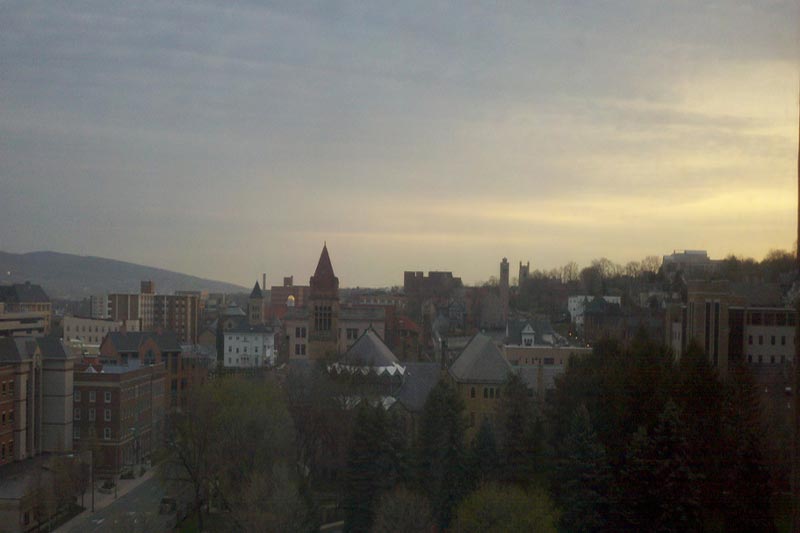For Tony
We have moved from the city to the country. The sky is dark, black, blank on cloudy nights and bursting with the white-hot heat of a thousand other galaxies full of lovers and poets, philosophers trying to figure out what it all means, what we mean, while we stare back at them on those rare crystal clear nights when the sky from our backyard is like a drug. Never enough, always too much.
This star-filled field lies only twenty miles north of the city-the small, depressed, former coal town in which we made love, made a family, made a home. If you’ve never been to Scranton, you haven’t missed much- the rebirth that we all pretend is coming, that we all work so hard to conjure up-isn’t. Because Scranton is, what Scranton was. In her heyday, she was a bustling Anthracite coal empire- a place where the poor and the meek- immigrants from Italy, Poland, and Ireland mostly, came with their families to carve out a better life in the mines below. To hear the residents tell it, Scranton was a microcosm of the roaring 20’s. Those who had- the coal barons, lived in iconic mansions peppered along the city’s Greenridge section. Flat, green land- city lots the size of a New York City block, all for one family, and usually one Irish, Catholic family with five kids, a dog, and a Ford Model A in the drive. And then there were those who had not: the workers.
The workers spread to the four corners and built neighborhoods: Cayuga, Hyde Park, Tripps Park, The Marvin. They build roads, they build churches and bars, they built American foursquares for their families. The women walked the children to school, shopped at the corner grocery, and hung bed sheets from nylon lines in their small, square backyards. After the unions came, the mines paid a good wage, and most families could afford a car and a summer vacation to the Jersey Shore. Seaside Heights, Wildwood, Point Pleasant. If you went in July, chances are half of your neighborhood would be there already. The men would get pints of beer and sit on the beach breathing the fresh air from which they or their fathers came, an ocean away, a life above ground.
Theirs was a life spent burrowing into the earth like moles. Fathers, brothers, uncles, they all woke up in the dark often with last night’s whiskey still heavy on their breath, kissed their wives goodbye and descended. They did this day after day after day until the mines went dry or the black lung took them- which it did, often.
When the mines dried up, so did the work. Scranton struggled to find other industries to keep her afloat. But she was a town built by honest, hardworking brutes and sustained by those immigrant families who had chased a fleeting glimpse of prosperity. Many didn’t speak English, and if they did, they usually lacked a formal education. Scranton’s workforce was powerful and strong, but uneducated and unable to sustain any industry other than some small, seemingly secure factories that would pop up in the region, feed the population for a few decades before inevitably closing and sending its workers to the unemployment line.
The coal left almost seventy years ago, and some might argue with it-any chance Scranton had to become something more than her poor, immigrant roots. But there are signs of the city she once was everywhere. Scranton has been called the city built on toothpicks. And every year or so, we are reminded of that fact when the ground, once pregnant with anthracite riches, collapses in on itself-pulling with it-half a house, a person, a car, whatever it can into the earth’s cold, barren womb. The neighborhoods are still there, but they’re mostly rentals now- the school houses now converted to apartments for the senior citizens who were probably students in that same building sixty years earlier. The Roman Catholic churches, once packed to the brim every single Sunday morning, have been converted to non-denominational housing shelters, soup kitchens, day care facilities, or they sit empty-wearing only the occasional vandalism and housing a few spaced out teenagers looking for a place to drink or have sex. The corner bars are still there, the only thriving reminder of the past, present, and future of this hard-fought city.
When we leave the city-we are a young family with two babies and a young and still interesting marriage. We move our family 20 minutes “up 81,” and I feel a twinge of guilt for giving up because that’s what Scranton demands of her remaining citizens- that they remain and they fight to reclaim something. Although no one is really sure what. There was life in this city before the mines- a trolley, electricity, a record company even, but my family came later, and that history has been long overshadowed by the dirt and grime that was the mines. I’m not sure what to reclaim here, and I don’t know if anyone else knows.
We haven’t gone far- twenty miles north is nothing for a Scrantonian. Most of us leave, most of us go much farther. Most of us never come back.
The stars in our new back yard-free from city light, look like glitter sprinkled across the dark, cavernous fold of a thick, velvet nothingness. There are patterns, no not only those studied by astronomers centuries ago but patterns only we can see. There is a trapezoid, a rectangle, geometrical strands of some other being, some other time.
On nights when we can see clearly, we take a blanket, lie in the field on our backs, and watch the universe. We feel the warm air on our skin; we live above ground. Underneath us, there are ghosts of the men who built this area. They lift us up now, hold us close to the sky. Breathe, they whisper, breathe it all in.
